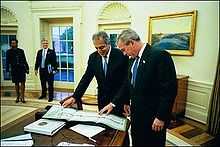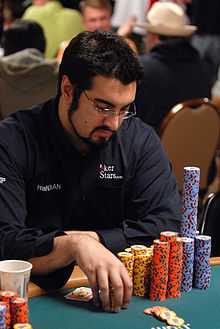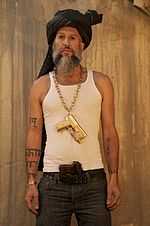Afghan American
| |||||||||||||
| Total population | |||||||||||||
|---|---|---|---|---|---|---|---|---|---|---|---|---|---|
| 300,000+[1] | |||||||||||||
| Regions with significant populations | |||||||||||||
| California, Northern Virginia, New York, Florida | |||||||||||||
| Languages | |||||||||||||
| American English, Dari Persian, Pashto and other languages of Afghanistan | |||||||||||||
| Religion | |||||||||||||
|
Predominantly Islam Minorities of Judaism[2] | |||||||||||||
Afghan Americans are Americans of Afghan heritage or Americans who originated from Afghanistan. Their ethnic origin may come from any of the ethnic groups of Afghanistan.
History and population
Afghan Americans have a long history of immigrating to the United States, as they may have arrived as early as the 1920s.[3] Due to the political borders at that time period, some of these Afghan immigrants may have been ethnic Pashtuns from British India (present-day Pakistan and India) or Afghanistan.[3] Wallace Fard Muhammad, credited for being the founder of the Nation of Islam, may have been from Afghanistan. A World War I draft registration card for Wallie Dodd Fard from 1917 indicated he was living in Los Angeles, California, as an unmarried restaurant owner, and reported that he was born in Shinka, Afghanistan in 1893.[4] During the 1930s and 1940s, well-educated Afghans entered America.[3] Between 1953 and early 1970, at least 230 migrated into the United States.[3] Some of those who entered the US were students who won scholarships to study in American universities. After the 1979 Soviet invasion of Afghanistan, around five million Afghan citizens were displaced, being forced to immigrate or seek refuge in other countries. These Afghan refugees mostly settled in neighboring Pakistan and Iran, and from there many made it to the European Union, North America, Australia, and elsewhere in the world.
Those who were granted asylum in the United States began to settle in California (mainly the Los Angeles-Orange County area and San Francisco Bay Area) and in the Northeastern United States, where large Muslim community centers keep them closely bonded. Fremont, California, is home to the largest population of Afghan Americans in the U.S.[5] Smaller Afghan American communities also exist in the states of Texas, Illinois, Florida, Washington and elsewhere.
According to the United States Census Bureau, there were approximately 65,972 Afghan-Americans living in the country in 2006. By 2011, this number grew to 89,040.[6] According to the Embassy of Afghanistan in Washington, DC, the over-all Afghan population in the United States in 2011 is around 300,000.[7] While 30,000 reside in Northern Virginia, approximately 65,000 Afghans comprise the diaspora community based in the San Francisco Bay Area.[7] Some figures estimate that there may only be about 80,000 Afghan-Americans but the actual number may be 200,000[8] to as high as 300,000.[7] Nevertheless, such higher figures may be an exaggeration, as a recent census of 2001 found approximately 9,000 of Afghan ancestry living in New York metro area, considerably lower than the 20,000 regularly cited.[9]
Culture
Like all other immigrants living in the United States, Afghan Americans have gradually adopted the American way of life but some still value their traditional culture. They watch Afghan television stations, listen to Afghan music, and eat traditional Afghan food at home. They also value their oral tradition of story telling. The stories they usually tell are about Nasreddin, Afghan history, myths and religion.[3]
Afghan Americans celebrate August 19 as "Afghan Day". It is a commemoration of the Afghan Independence Day, which relates to August 1919, the date when Afghanistan became globally recognized after the Anglo-Afghan Treaty of 1919 was signed. Small festivals are held in cities that have Afghan communities, usually at the parks where black, red and green colored Afghan flags are spotted around cars.[10]
Ethnicity and religion
Afghan Americans are composed of the various ethnic groups that exist in Afghanistan, which include Pashtun, Tajik, Hazara, Uzbek, and a number of others.
Most Afghan Americans are Muslim, the majority of whom follow Sunni Islam. The ethnic Hazaras and Qizilbash are the only ones who follow Shia Islam. A small number of Tajiks follow Ismailism.
There is a community of Afghan Jews in New York City, numbering about 200 families in 2007.[2] In addition, a group of Afghan Americans in the Los Angeles area follow Christianity.[11] Hussain Andaryas is an Afghan Christian televangelist who belongs to the Hazara ethnic group.
There is also an unknown minority of Afghan Sikhs and Hindus.[12]
Economic status
While the early immigrants were well-educated, the subsequent waves of migrants have not been as educated.[3] The first immigrants came to the US by choice and were well-educated.[3] In contrast, current immigrants have fled Afghanistan after it destabilized during the Soviet occupation as this group has had trouble coping with learning a new language.[3] Those who have pursued their education in America in the middle 20th century and traveled back to Afghanistan, faced trouble attaining employment when returning to the US since their education, often in medicine and engineering, is frequently viewed as outdated.[3] After the Soviet invasion, Afghanistan's education system worsened, causing many migrants in the late 20th century to place less emphasis on educational attainment.[3]
A sizable number of Afghan Americans who do not seek higher education often enter into food industry, mainly in running Afghan cuisine restaurants and fast food establishments such as Kennedy Chicken.[13] Some of the newcomers to America can be found as venders in Manhattan where they have replaced Greek Americans in the field.[14]
Notable Afghan Americans


Athletics
- Alex Hinshaw - Afghan American Baseball Pitcher [15]
- Jeff Bronkey - Former baseball player who is born to an Afghan father and American mother [15]
- Ahmad Hatifi - Afghan American soccer player who plays for the national Afghan Soccer Team [16]
Politics and academia
- Ali Ahmad Jalali - Distinguished Professor at the National Defense University in Washington, D.C.
- Said Tayeb Jawad - Ambassador of Afghanistan to the United States from 2003 to 2010
- Zalmay Khalilzad - United States Ambassador to the United Nations from 2007 to 2009. He previously served as United States Ambassador to Afghanistan and United States Ambassador to Iraq
- Mohammad Qayoumi - President of San Jose State University
- Nazif Shahrani - Professor of anthropology at Indiana University
- Ishaq Shahryar - Afghan Ambassador to the United States from 2002 to 2003
- Wali Karzai - Professor of Bio-Chemistry at Stony Brook University
- Ali A Olomi - Historian and writer
- M. Ishaq Nadiri - Professor of economics at NYU[17] and signatory at 2001 Afghanistan Bonn conference
- Nake M. Kamrany - professor of economics at USC [18][19]
- Haris Tarin - American Muslim leader who is Director of Muslim Public Affairs Council( MPAC)[20]
- Wallace Fard Muhammad - American Muslim leader who founded the nation of islam[4]
Business and finance
- Mahmoud Karzai - Brother of Afghan President Hamid Karzai and owner of Afghan cuisine restaurant
- Quayum Karzai - Brother of Afghan President Hamid Karzai and owner of Afghan cuisine restaurants in the Southern California and Baltimore–Washington Metropolitan Area
- Ehsan Bayat - Business entrepreneur who founded Afghan Wireless
- Abdul W. Haqiqi - Economist and co-author of a number of published and cited works concerning Islamic banking accounting standards
- Baktash Khadem Zaher - Founder and CEO of Paramount Business Jets, Graduate of Embry-Riddle Aeronautical University[21]
Literature
- Tamim Ansary - Author of West of Kabul, East of New York, a book published in 2001, shortly after the "9-11" attacks.
- Khaled Hosseini - Famous author, his work includes the Kite Runner and A Thousand Splendid Suns
- Fariba Nawa - Author of Opium Nation and Journalist
Media and art

- Azita Ghanizada - Actress and TV host, she appeared in a number of films and TV shows
- Sonia Nassery Cole- Actress and director
- Anwar Hajher - Filmmaker who directed 16 Days in Afghanistan, a documentary about life after the Taliban.
- Youssof Kohzad - Artist, Poet, Painter and Actor
- Zakia Kohzad - former Afghan actress and news anchor
- Mithaq Kazimi - Filmmaker, producer of 16 Days in Afghanistan
- Nabil Miskinyar - Television anchor
- Jawed Wassel - Writer/Director of first Afghan Oscar contender Feature Film called FireDancer.
- Josh Gad - Actor from jobs. Half Afghan Jewish Dad.
- Leena Alam Actress from Kabuli Kid, Loori, Soil and Coral, The Unknown and more.
- Fahim Fazli - Actor who appears in various film, such as iron man[22]
- Ali Olomi - Actor who appears in various T.V Shows [23]
- Robert Joffrey- born Abdullah Jaffa Bey Khan is known for co-founder of the Joffrey Ballet
- Aman Mojadidi- Afghan American Artist whose art projects focus on Afghan politics and cross-cultural identity.[24]
Afghan music singers
- Ehsan Aman - Artist and music composer of Afghan music
- Farhad Darya - Singer of Afghan music
- Jawad Ghaziyar - Singer of Afghan music
- Rahim Jahani - Singer of Afghan music
- Naim Popal - Singer of Afghan music
- Haidar Salim - Singer of Afghan music
- Mariam Wafa - Singer of Afghan music
- Ahmad Wali - Singer of Afghan music
- Omar Akram - Afghan American Pianist who won a Grammy award for best new age album [25][26]
- Aziz Herawi- famous Afghan Classical musician
Beauty pageant contestants
Afghan royalty
- Ahmad Shah Khan - Former Crown Prince of Afghanistan and current pretender to the throne
Other
- Rishad Zahir - Son of Afghan singer Ahmad Zahir
- Zahira Zahir - Sister of Afghan singer Ahmad Zahir
- Alexander Benard - Lawyer and Businessman who is the son of Zalmay Khalilzad
- Hevad Khan - Professional Poker player[27]
War in Afghanistan (2001–present)
After the September 11 attacks in 2001, a mosque run by Afghan-Americans in New York City donated blood held a vigil for World Trade Center deceased and funded a memorial for the fire fighters.[28] Since late 2001, after the start of the U.S. war in Afghanistan, some Afghan-Americans began working for the U.S. government as interpreters.
See also
- Afghanistan – United States relations
- Demography of Afghanistan
- Afghan diaspora
References
- ↑ "Afghan Community: Afghan American Demographics". Allied Media Corp.
- ↑ 2.0 2.1 "U.S.: Afghan Jews Keep Traditions Alive Far From Home". Nikola Krastev. Radio Free Europe/Radio Liberty (RFE/RL). June 19, 2007. Retrieved 2013-09-07.
- ↑ 3.0 3.1 3.2 3.3 3.4 3.5 3.6 3.7 3.8 3.9 Eigo, Tim. Countries and their Cultures. "Afghan Americans." 2006. July 6, 2007.
- ↑ 4.0 4.1 Ancestry.com database, Registration Location: Los Angeles County, California; Roll: 1530899; Draft Board: 17
- ↑ San Francisco Chronicle, Fremont's Little Kabul eyes election with hope, August 21, 2009.
- ↑ "Total Ancestry Reported". 2011 American Community Survey 1-Year Estimates. U.S. Census Bureau. Retrieved 11 December 2012.
- ↑ 7.0 7.1 7.2 Afghan Diaspora
- ↑ USA Today, 'Little Kabul' immigrants apprehensive (2001)
- ↑ Andy A Beveridge. "New York's Divided Afghans". Gotham Gazette: The Place for New York Policy and Politics. Retrieved 17 March 2015.
- ↑ Afghan Embassy news letter
- ↑ "Afghan Christian Fellowship, Los Angeles". Retrieved 17 March 2015.
- ↑ "Discover Countries - Afghanistan". Retrieved 26 February 2015.
- ↑ The New York Times - KFC v. KFC
- ↑ The Face Behind the Bagel ; Afghan Newcomers Use Coffee Carts to Succeed As Vendors of New York's Rush-Hour Breakfast
- ↑ 15.0 15.1 "Blue Jays: Pitcher Hinshaw comes from exotic background: DiManno". thestar.com. 21 February 2013. Retrieved 17 March 2015.
- ↑ "Ahmad Hatifie Bio - UC Davis Official Athletic Site". Retrieved 17 March 2015.
- ↑ "M. Ishaq Nadiri, Faculty of Department of Economics - NYU". Retrieved 17 March 2015.
- ↑ "Nake M. Kamrany". Retrieved 17 March 2015.
- ↑ "Nake M. Kamrany, Ph.D., J.D.". Retrieved 17 March 2015.
- ↑ "Rising Muslim American leader in D.C. speaks for his generation". Washington Post. Retrieved 17 March 2015.
- ↑ "Tribeca man returns home to help Afghan widows". Retrieved 17 March 2015.
- ↑ "Authors". Fahim speaks. Retrieved 17 March 2015.
- ↑ "Ali Olomi". IMDb. Retrieved 17 March 2015.
- ↑ Aman Mojadidi, Special to CNN (27 January 2013). "An 'Afghan redneck' creates art in a war zone". CNN. Retrieved 17 March 2015.
- ↑ "Omar Akram". Last.fm. Retrieved 17 March 2015.
- ↑ "Omar Akram". The GRAMMYs. Retrieved 17 March 2015.
- ↑ Nicole Gordon. "The PokerNews Profile: Hevad Khan". Retrieved 17 March 2015.
- ↑ "BBC News - AMERICAS - Troubling times for Afghan-Americans". Retrieved 17 March 2015.
External links
| Wikimedia Commons has media related to Afghan Americans. |
- Afghan American Demographics
- Afghan-American Chamber of Commerce
- 'Little Kabul' immigrants apprehensive (2001)
- In Va.'s Little Kabul, Joy; Afghans' Celebration Tempered by Fears Of Renewed Division
| ||||||||||||||||||||||
| ||||||||||||||||||||||||||||||||||||||||











